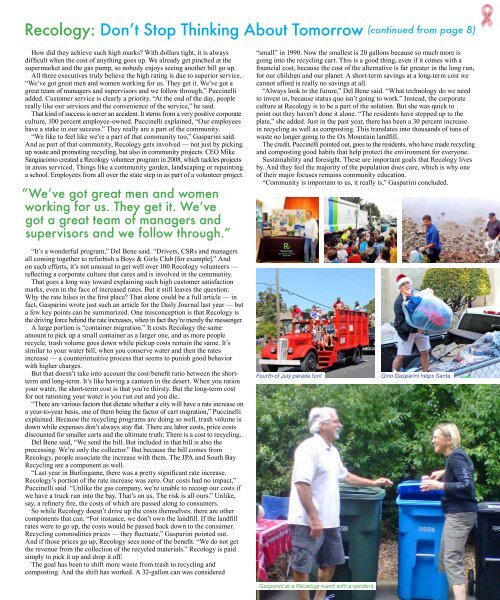4:00pm 11:00am - The Spectrum Magazine - Redwood City's ...
4:00pm 11:00am - The Spectrum Magazine - Redwood City's ...
4:00pm 11:00am - The Spectrum Magazine - Redwood City's ...
You also want an ePaper? Increase the reach of your titles
YUMPU automatically turns print PDFs into web optimized ePapers that Google loves.
Recology: Don’t Stop Thinking About Tomorrow (continued from page 8)<br />
How did they achieve such high marks? With dollars tight, it is always<br />
difficult when the cost of anything goes up. We already get pinched at the<br />
supermarket and the gas pump, so nobody enjoys seeing another bill go up.<br />
All three executives truly believe the high rating is due to superior service.<br />
“We’ve got great men and women working for us. <strong>The</strong>y get it. We’ve got a<br />
great team of managers and supervisors and we follow through,” Puccinelli<br />
added. Customer service is clearly a priority. “At the end of the day, people<br />
really like our services and the convenience of the service,” he said.<br />
That kind of success is never an accident. It stems from a very positive corporate<br />
culture, 100 percent employee-owned. Puccinelli explained, “Our employees<br />
have a stake in our success.” <strong>The</strong>y really are a part of the community.<br />
“We like to feel like we’re a part of that community too,” Gasparini said.<br />
And as part of that community, Recology gets involved — not just by picking<br />
up waste and promoting recycling, but also in community projects. CEO Mike<br />
Sangiacomo created a Recology volunteer program in 2008, which tackles projects<br />
in areas serviced. Things like a community garden, landscaping or repainting<br />
a school. Employees from all over the state step in as part of a volunteer project.<br />
“We’ve got great men and women<br />
working for us. <strong>The</strong>y get it. We’ve<br />
got a great team of managers and<br />
supervisors and we follow through.”<br />
“It’s a wonderful program,” Del Bene said. “Drivers, CSRs and managers<br />
all coming together to refurbish a Boys & Girls Club [for example].” And<br />
on such efforts, it’s not unusual to get well over 100 Recology volunteers —<br />
reflecting a corporate culture that cares and is involved in the community.<br />
That goes a long way toward explaining such high customer satisfaction<br />
marks, even in the face of increased rates. But it still leaves the question:<br />
Why the rate hikes in the first place? That alone could be a full article — in<br />
fact, Gasparini wrote just such an article for the Daily Journal last year — but<br />
a few key points can be summarized. One misconception is that Recology is<br />
the driving force behind the rate increases, when in fact they’re merely the messenger.<br />
A large portion is “container migration.” It costs Recology the same<br />
amount to pick up a small container as a larger one, and as more people<br />
recycle, trash volume goes down while pickup costs remain the same. It’s<br />
similar to your water bill, when you conserve water and then the rates<br />
increase — a counterintuitive process that seems to punish good behavior<br />
with higher charges.<br />
But that doesn’t take into account the cost/benefit ratio between the shortterm<br />
and long-term. It’s like having a canteen in the desert. When you ration<br />
your water, the short-term cost is that you’re thirsty. But the long-term cost<br />
for not rationing your water is you run out and you die.<br />
“<strong>The</strong>re are various factors that dictate whether a city will have a rate increase on<br />
a year-to-year basis, one of them being the factor of cart migration,” Puccinelli<br />
explained. Because the recycling programs are doing so well, trash volume is<br />
down while expenses don’t always stay flat. <strong>The</strong>re are labor costs, price costs<br />
discounted for smaller carts and the ultimate truth: <strong>The</strong>re is a cost to recycling.<br />
Del Bene said, “We send the bill. But included in that bill is also the<br />
processing. We’re only the collector.” But because the bill comes from<br />
Recology, people associate the increase with them. <strong>The</strong> JPA and South Bay<br />
Recycling are a component as well.<br />
“Last year in Burlingame, there was a pretty significant rate increase.<br />
Recology’s portion of the rate increase was zero. Our costs had no impact,”<br />
Puccinelli said. “Unlike the gas company, we’re unable to recoup our costs if<br />
we have a truck run into the bay. That’s on us. <strong>The</strong> risk is all ours.” Unlike,<br />
say, a refinery fire, the costs of which are passed along to consumers.<br />
So while Recology doesn’t drive up the costs themselves, there are other<br />
components that can. “For instance, we don’t own the landfill. If the landfill<br />
rates were to go up, the costs would be passed back down to the consumer.<br />
Recycling commodities prices — they fluctuate,” Gasparini pointed out.<br />
And if those prices go up, Recology sees none of the benefit. “We do not get<br />
the revenue from the collection of the recycled materials.” Recology is paid<br />
simply to pick it up and drop it off.<br />
<strong>The</strong> goal has been to shift more waste from trash to recycling and<br />
composting. And the shift has worked. A 32-gallon can was considered<br />
“small” in 1990. Now the smallest is 20 gallons because so much more is<br />
going into the recycling cart. This is a good thing, even if it comes with a<br />
financial cost, because the cost of the alternative is far greater in the long run,<br />
for our children and our planet. A short-term savings at a long-term cost we<br />
cannot afford is really no savings at all.<br />
“Always look to the future,” Del Bene said. “What technology do we need<br />
to invest in, because status quo isn’t going to work.” Instead, the corporate<br />
culture at Recology is to be a part of the solution. But she was quick to<br />
point out they haven’t done it alone. “<strong>The</strong> residents have stepped up to the<br />
plate,” she added. Just in the past year, there has been a 30 percent increase<br />
in recycling as well as composting. This translates into thousands of tons of<br />
waste no longer going to the Ox Mountain landfill.<br />
<strong>The</strong> credit, Puccinelli pointed out, goes to the residents, who have made recycling<br />
and composting good habits that help protect the environment for everyone.<br />
Sustainability and foresight. <strong>The</strong>se are important goals that Recology lives<br />
by. And they feel the majority of the population does care, which is why one<br />
of their major focuses remains community education.<br />
“Community is important to us, it really is,” Gasparini concluded.<br />
Fourth of July parade fun! Gino Gasparini helps Santa.<br />
Gasparini at a Recology event with a resident.<br />
<strong>The</strong> <strong>Spectrum</strong> <strong>11</strong>

















